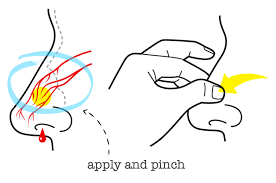What is a nosebleed?
A nosebleed occurs when the membranes lining the inner nose are disturbed or irritated enough to cause abnormal bleeding. The medical term is epistaxis. If the bleeding is near the front of the nose, it is an anterior bleed. In children it is almost always of the anterior type. Anterior bleeds are common in dry climates or during the winter months when the dry air parches the nasal membranes so that they crust, crack, and bleed. A posterior bleed occurs in the back of the nose and is more likely to occur in older people and may be more difficult to locate the site of the damage.
Why is the nose prone to bleeding?
The nose has many blood vessels in it to help warm and humidify the air you breathe. These vessels lie close to the surface, making them easy to injure.
Causes:
- Dry air: Dry air can cause the delicate tissues inside the nose to become dry and irritated, leading to nosebleeds.
- Trauma: Any type of trauma to the nose, such as a blow to the face or nose picking, can cause nosebleeds. Sometimes a deviated nasal septum may be the cause.
- Infection: Infections in the nose or sinuses can cause inflammation and irritation, leading to nosebleeds.
- Underlying medical conditions: Some underlying medical conditions, such as high blood pressure or bleeding disorders, can increase the risk of nosebleeds.
First Aid
Most bleeds will stop after the application of first aid by the patient.
- When your nose starts bleeding, sit up and lean forward to prevent blood from passing into your throat, which may cause choking.
- Pinch the nose firmly together between the thumb and index finger, just below the nasal bones, and hold it for 10 minutes.
- Applying ice: Placing ice on the bridge of the nose in case of a blow, can help constrict the blood vessels and reduce bleeding.
- Using nasal decongestants: Nasal decongestants can help shrink the blood vessels in the nose and reduce bleeding.
- If the bleeddoes not respond to first aid or lasts more than 20 minutes, it is necessary to see an ENT specialist.
Cauterization: In severe cases, cauterization may be necessary to stop the bleeding. This involves using heat or chemicals to seal the blood vessels in the nose.
Nasal Packing may be used to treat nosebleeds not responsive to cautery. Patients will receive antibiotics to prevent infection.
While most bleeds stop with cautery and/or packing, severe or recurrent bleeding may require surgical treatment.
Prevention:
- When you have a nasal infection, use a saline nasal spray to keep the nose moist.
- Avoid injuring the nasal mucosa with nose-picking, rubbing, or forceful blowing.
- Keep children’s fingernails short to discourage nose picking.
- Quit smoking. Smoking dries out your nose and also irritates it.


Recent Comments